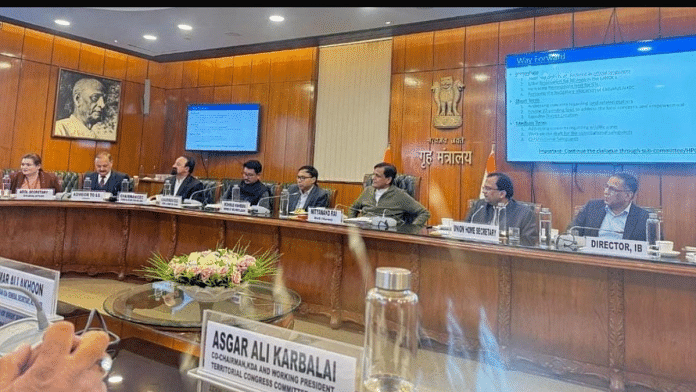New Delhi: In a meeting of a high-powered committee—set up by the Ministry of Home Affairs for the development of Ladakh—regional representatives and Centre agreed to a 95 percent job quota for Ladakhi people in government jobs in the Union Territory, one-third reservation for women in hill councils, a draft to ensure “constitutional safeguards”, and inclusion of Urdu and Bhoti as the official languages of Ladakh.
The HPC, chaired by Minister of State for Home Affairs Nityanand Rai, met eight leaders each from Leh and Kargil regions, who represented the Leh Apex Body and Kargil Democratic Alliance (KDA), to discuss key demands, including that of statehood.
Sajjad Kargili of KDA told ThePrint that the meeting was “fruitful” as the central government heard the demands proposed by them and committed that 95 percent of government jobs will be reserved for local residents of Ladakh. The focal point of the meeting was “recruitment”, he said.
“Unemployment is at an all-time high in Ladakh and is affecting the young population of the UT. It is a major issue and needs to be tackled on priority. The Centre assured us that the recruitment will begin soon.”
The panel has made four key demands—statehood for Ladakh, inclusion under the Sixth Schedule of the Constitution, a public service commission for Ladakh, and separate Lok Sabha seats for Leh and Kargil districts.
Kargili also said that they have demanded a separate public service commission for Ladakh, but that is currently not possible constitutionally as the UT does not have a legislature. He added, however, that this is one of their key demands and will be taken up in future meetings, and the first phase of recruitment will be done by the Union Public Service Commission.
“We were told that recruitments for gazetted candidates can be done through the Jammu and Kashmir Public Service Commission (JKPSC). We told them that we do not want it through DANICS (Delhi, Andaman & Nicobar, Lakshadweep, Daman and Diu and Dadra and Nagar Haveli Civil Services), but it was decided that the first phase of recruitment will be done via UPSC,” Kargili told ThePrint.
Kargili added that the Centre was also told that the 95 percent job reservation should be based on the Ladakh Residence Certificate (LRC) that is issued to local residents.
“We can’t let our youths sit idle for more time. This round of recruitment should begin and should be done on the basis of who holds the LRC to ensure that locals get the benefit.”
The next meeting for further discussion on their demands will be held on 16 December.
Ladakh has been protesting for the past five years, since it lost constitutional safeguards that were ensured under Article 370 of the Constitution.
The transition of Ladakh into a UT, following the abrogation of Article 370 in 2019 and the bifurcation of the erstwhile state of Jammu and Kashmir—of which Ladakh was previously a part— initially elicited celebration among residents as they had always accused the J&K leadership of being discriminatory and ignorant towards their region.
The Sixth Schedule empowers tribal communities with a degree of autonomy in governance, enabling them to manage their own affairs and resources. Tribals are estimated to make up more than 90 percent of the population in Ladakh.
Another concern is Ladakh’s fragile ecology that can be severely impacted by an influx of industries, setting up of solar plants, hydropower projects and mining projects, once it is thrown open for all.
With Ladakh becoming a UT, residents expected better administration, representation in Parliament, access to government funds and resources, and a heightened focus on development. But soon after the central government declared Ladakh a UT without legislature, many in the region began to rise in protest demanding autonomy, jobs and safeguards for land and culture, leading to a full-blown protest with over 20,000 people joining activist Sonam Wangchuk in his hunger strike starting May this year.
(Edited by Mannat Chugh)






